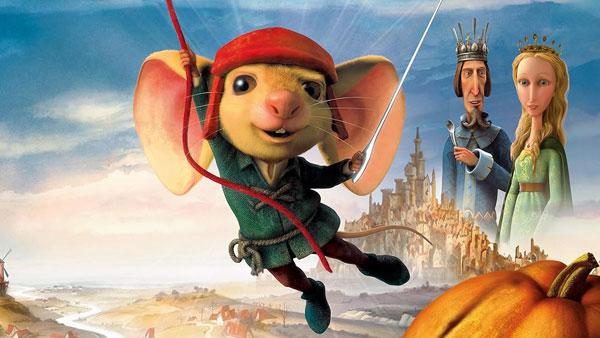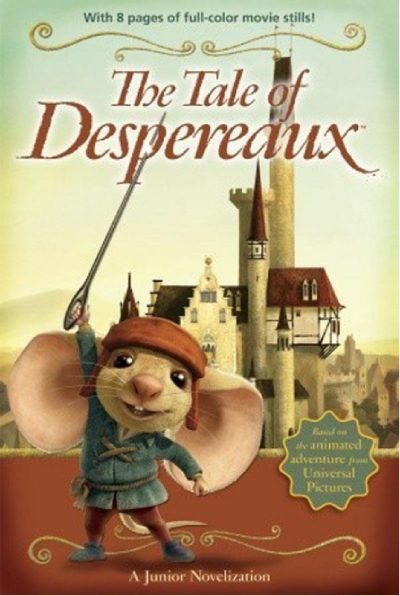If your child enjoys The Tale of Despereaux, then it isn’t just about following along with an intriguing narrative. You can actively help your child develop key foundational social and emotional skills while having fun.
However, as the story is available digitally, there is a possibility that children may become screen addicts. This article first addresses the plot points and central themes of Despereaux. After this, we will share techniques that safely keep your child engaged without losing balance!
Plot overview of The Tale of Despereaux
The Tale of Despereaux is about a strange mouse called Despereaux Tilling. He unlike other mice, loves music and stories, as well as a human princess named Pea. As any mouse would do, he appears to break the rules and is then sent to the dreaded dungeon. Thus, he indulges in an adventure rescuing the princess and bringing light back to the kingdom.
Other than Despereaux Tilling, you meet Roscuro, who becomes bitter, aiming to hurt the world. Also, you come across the Miggery Sow, a servant girl who desperately dreams of becoming a princess. All move in a ’cause and effect’ manner, altering each other’s lives with these interconnections.
Main themes in The Tale of Despereaux
The morals of this story will resonate with younger readers. These themes provide parents with a chance on how they can help their kids be more empathetic, learn kindness and become strong day to day.
Bravery and courage:
Even if the world is largely unknown to him, Despereaux never lets fear hold him back. He does what his heart tells him to do, even if people laugh at him or urge him to keep silent. He speaks to princesses, defends just causes, and journeys deeply into the dungeons for the sake of helping someone he loves.
Thus, it allows kids to learn that true courage is being able to stand up for themselves regardless of how much it terrifies them. Sharing relatable stories can be really helpful in conveying this message.
Remind them about all those times your child displayed courage. For instance; when giving a presentation in class or trying out new stunts like riding a bicycle without one and changing schools. Even simple acts such as speaking honestly or helping someone who feels isolated show great bravery.
As an additional aid, I recommend acting out situations where you’d both confront fears together and take turns being “the bold knight.” Thus, children acquire the understanding that there are countless ways to express courage without needing to be serious.



Friendship and loyalty
As much as the friends Despereaux makes along his journey shape it, so does the loyalty he has for them. For instance, he stays loyal to Princess Pea by doing everything possible to assist her even when the odds turn against him.
Friendship teaches us that genuine companions are those who care about each other selflessly during both joyful and challenging moments. This is a great chance for you as a parent to share with your child the meaning of friendship.
For instance, they may have comforted a sad classmate or shared a toy with a sibling. Such small acts are essential to nurturing trust and kindness towards others.
Forgiveness and redemption
Not every story character makes good choices at the beginning. For instance, Roscuro has hurt feelings and anger. While Miggery Sow is often lost in her own peculiar dreams. Yet, both learn that change is possible, which is quite freeing, and begin a new course of action.
Right now, let’s think about encouraging deep dives with children on times when they’ve decided to forgive someone, or be forgiven in turn. Parents could be discussing these examples: siblings arguing but one deciding to make peace. Moreover, saying sorry after having done something wrong, or apologising unilaterally without reciprocation needed from anyone else.
Such moments in life will demonstrate why accepting forgiveness plays an important role in personal development.
Keep their imaginative adventures safe with FlashGet Kids‘ real-time monitoring.
The adaptations: book, movie, and games
The Tale of Despereaux has been transformed into books, animated movies, and stage performances. This is in part due to the soft and warm features that make every child smile. Of course, every adaptation keeps the moral lessons about hope, courage, and kindness. But tells them through different methods, which is unique on its own. Such variety is joyful as you are able to help your child explore deeper in analyzing stories with differing methods of telling them.
Let’s delve into what makes each adaptation different yet similar at the same time.
The Book
Every journey has its origins, and this story starts from Kate DiCamillo‘s book. The voice that tells the story is warm and nurturing and speaks directly to the reader, which is ideal for a child. They become part of Despereaux, Princess Pea, Roscuro, and Miggery Sow’s world.
The book explains the importance of feelings through actions so your child understands the mistakes made as well as the dreams achieved. Rather than being given simplistic emotions or understanding restricted to just intellect, this version allows them engagement.



Animated Movie
There was an animation made back in 2008, and it differs significantly from the text. Actions are better rewarded with bright colors in the plot. Moreover, this movie version shows Despereaux as more bold toward heroism. Similarly, you will see Roscuro to be more focused on taking revenge. For no reason at all, new scenes ruin old tales while dragging over pointless extensions not needed for children’s narratives.
Regardless of these differences, if you are looking forward to watching this with your kid, then, make sure that there is a conversation being held revolving around activities done in comparison to things read beforehand. For instance, you may ask: Wondering “Why do you suppose that part was altered?” or “Did you feel differently about him after watching?” cultivates critical reasoning.”
Games and stage adaptations
By using costumes, lights, and music, actors have performed stage adaptations of Despereaux. Thus, bringing to life elements of the story for children, which sparks their imagination beyond reading comic strips.
Despereaux’s character features in simple adventure games and puzzles designed for youngsters. These games become even more enjoyable when children spend less time on screens and engage in offline activities as well.
And yet, I have to point out that reading alongside others sounds less exciting than doing it together as a family. This helps deepen comprehension while appreciating creativity with a wealth of knowledge, all wrapped up in bonding.
Why does it appeal to all ages?
The Tale of Despereaux is one story that resonates with all ages. It combines adventure and wonderful lessons, making it easy for both kids and adults to appreciate a good story. This is one story that sticks with you regardless of how many times you read it; from childhood to parenthood. There will always be something new to discover in every reading.
Cross–generational appeal:
Families link themselves to a single plot because every character relates to more than one dimension. For example, kids love talking animals, magical castles, and spectacles – the appealing parts of a story. In this case, they absorb Despereaux’s courage along with acute perception about right and wrong.
On the flip side, those grown up concentrate on deeper things. For instance, they might focus on pain that comes before joy, traces anger, Roscuro exhibits. While loneliness is seen in Miggery Sow paired with strength through forgiving.
A single story, multiple perspectives
The reading experience with your kid turns out to be a revelation because every person has their own interpretations. For you, a child might enjoy Despereaux as a brave and fun-loving character, but you would think of him as someone who overcomes tremendous odds, as he is a true hero.
Both interpretations offer something useful, which enhances the quality of the reading session. Thus, it provides great moments where children discuss themes such as bravery, sadness, dreams and love with memorable characters.
Learning from challenges
What really adds meaning to the story is its sense of hope. Every character has problems, but they also have the opportunity to realise and appreciate something deeper because of their problems. Despereaux teaches us that the tiniest individual is capable of making massive impacts.
Roscuro comes to understand that even mistakes need not define one’s entire existence. Miggery aspires for greater things but finds instead that he learns the virtue of love. There’s lots to learn here that no matter how young or old you are, and irrespective of your history, you can face challenges, triumph remarkably, and uncover what matters in life.
Managing media and screen time while kids explore the Tale of Despereaux
If your child is reading or watching The Tale of Despereaux, you might want to allow them to experience the story while supervising in a more hands-off way. Since it encompasses a lot of meaning and emotion, it is worth controlling the amount of media children consume. So that they can learn from the experience while nurturing good behavioral patterns.
When combined with real-life activities, screen time has value, which makes the story more valuable. Let’s explore how we can guide your child through this journey.
Monitoring movie adaptations:
Animated adaptations, such as The Tale of Despereaux, capture the vivid action of the story and are enjoyable to watch. However, they do not always follow the story verbatim. With film versions, there is always room for conversations where guiding questions like “Did Despereaux behave along those lines in the book?” or “What was different about that part in the book?” can be posed.
These inquiries will help develop your child’s critical thinking skills. Additionally, you can protect your family’s principles and values while controlling screen time by watching together. So your child does not have to sit alone for long periods of time but rather engage with narratives with you. Learning becomes something done together instead of simply entertainment.
Digital reading habits:
Moreover, if your kids love to read on smart gadgets, then it’s acceptable. But you have to ensure their digital safety with the help of parental control features. One such example is FlashGet Kids, which allows parents to manage their children’s screen time activities more efficiently.



Owing to this app, you can monitor book engagement time, block non-educational apps, and set specific times for reading sessions. Thus, you get relief as a parent knowing that he is spending his time in constructive ways appropriate for his age.
Engaging with the book offline:
The benefit of offline book reading is that kids utilize time to extend narratives beyond the pages and into the real world effortlessly. Children have various ways to bring their favorite characters to life. For instance, they may draw, role-play, or enact courageous deeds while articulating rational solutions to problems posed. These methods offer a richer comprehension of the characters as they move between imaginary worlds and reality.
With imaginative storytelling coupled with hands-on learning, books become active educational tools instead of being something that children passively read or watch.
Conclusion
To summarize, The Tale of Despereaux is a wonderful story that exceptionally educates your child on compassion, bravery, and optimism. However, due to its cinematic adaptation, there is a chance that children will spend excessive amounts of time on screens, neglecting academics and their health. This highlights the importance of balanced screen time as well as guiding digital habits for children.
No need to worry; you can utilize FlashGet Kids parental control software, which offers time management features alongside safe browsing, which fosters a protected learning environment. Thus, educators and caregivers can rest assured that every experience will become purposeful alongside managed time online.

